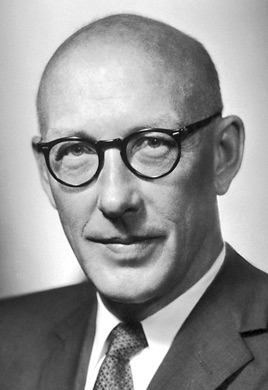
Edward Lawrie Tatum was born on December 14, 1909, in Boulder, Colorado. to Arthur L. Tatum and Mabel Webb Tatum. Arthur L. Tatum was a chemistry professor, who became in 1925, a professor of pharmacology at the University of Wisconsin at Madison. On graduation from high school, Edward enrolled at the University of Chicago and after for two years, transferred to the University of Wisconsin at Madison where he graduated with his BA in 1931 and his PhD in 1934. Tatum’s dissertation was titled, Studies in the biochemistry of microorganisms. This research opened the investigation of the connection between the gene function and biochemical processes.
Edward Tatum’s major achievement came in his collaboration with George Beadle. During the 1940’s, they conducted influential experiments that elucidated the relationship between genes and enzymes. Their work, conducted on bread mold (Neurospora crassa), demonstrated that bombarding bread mold with X-rays causes mutations in particular enzymes, providing insights into the role of mutations in human evolution. This groundbreaking research laid the foundation for the “one gene, one enzyme” hypothesis, a pivotal concept in molecular biology.
In 1958, Tatum was awarded the Nobel Prize in Physiology or Medicine, jointly with Beadle and Joshua Lederberg, for their discoveries concerning the relationship between genes and the synthesis of enzymes. This recognition solidified Tatum’s position as a pioneer in genetics and molecular biology.
Throughout his career, Tatum made substantial contributions to the field of microbiology, focusing on microbial genetics, biochemical pathways, and the role of genes in protein synthesis. He served as a professor at various prestigious institutions, including Stanford University and the Rockefeller Institute for Medical Research.
Edward Tatum passed away on November 5, 1975, leaving behind a lasting legacy in genetics and molecular biology, and his work continues to inspire and shape scientific research in these fields. Summarizing his insight into the connection between mutations and natural selection, Tatum stated:
“In microbiology the roles of mutation and selection in evolution are coming to be better understood through the use of bacterial cultures of mutant strains.”
